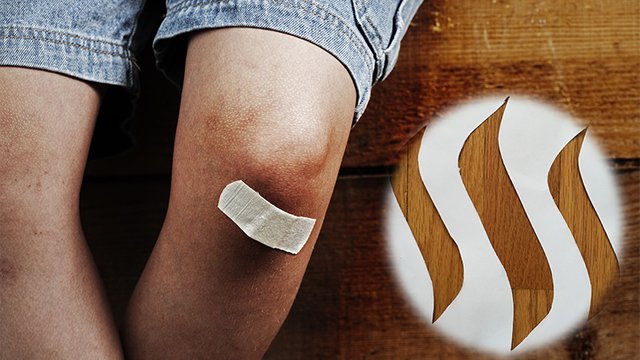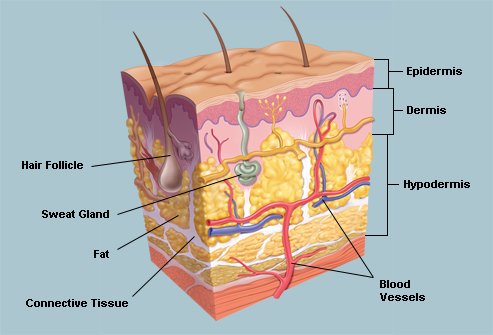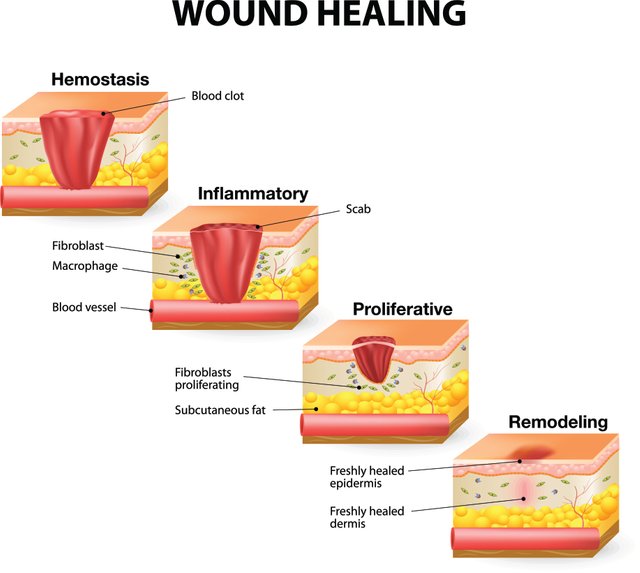
Our skin is exposed to many dangers - bruises, cuts, scratches and other wounds can accur quite easily.
But have you ever asked yourself how the body manages to heal those wounds - by itself?
Of course I don't mean a serious injury, but a wound on the skin's surface - the body is able to close up those wounds and renew the skin, all by itself.
Structure of the Skin
Our skin is made up of several different layers that protect the sensitive tissue and nerves underneath.
The top layer is called Epidermis, which provides the most protection.
It consists mostly of hardened cells, and it's quite easy and quickly for the body to repair it, since it sheds and renews constantly anyway.
Below the Epidermis lays the layer called Dermis - this is where all the functions of our skin operate.
Our skin can regulate the temperature, emit sweat, grow hair, sense touch, etc.
So this layer contains many blood vessels, nerve endings and glands that provide the skin with these functions.

Regenerative Process
When we experience a cut or wound, a regenerative process takes place. This can be divided into different steps:
1.) Hemostasis
When our skin is damaged, it's the body's first priority to stop the bleeding, so we don't loose too much blood. Also, it's crucial to replace the epidermis protection temporarily, until new skin tissue can be generated later.
To achieve this, blood cells start clumping together, creating a clot that closes the wound and hinders blood from flowing out.
A protein called fibrin also helps to keep the clot in place, as it forms cross-links on top of the skin, so no bacteria can get in and no more blood can get out.
These clots later turn into scabs as they've dried out, and fall out if the tissue underneath has renewed.
2.) Inflammation
Once the immediate threat of blood loss is under control, the healing process starts.
The previously contracted blood vessels now open again to let nutrients, oxygen and specialized cells flow to the wound.
The most important of these cells are white blood cells, which devour any bacteria that might have gotten in through the wound, as well as encourage healing and produce growth factors.
Blood-borne oxygen is also a crucial part of this stage, which stimulates further healing.

3). Proliferation
After 2-3 days, the healing processes even further and new tissue is being created.
The so-called fibroblast cells produce collagen and new skin tissue, which now connect to the makeshift barrier of fibrin from before, and replace it in the end.
The dermis narrows again to close up the wound, while the epidermis cells form a new, protective layer over the wound by cell division.
4.) Restoring and Strengthening
This last step can actually take up to several years, depending on the initial severeness of the wound, but most of it will be completed within a few months for a light injury.
The skin is now completely recovering, new collagen is being converted into different types that give the skin its functions back, the strength and flexibility of the skin is being improved, while blood vessels and other connections are being strengthened as well.
During this process, the skin might itch, which is always a sign that new tissue is being grown or remodeled.
If the wound was critical, the skin might never fully recover, and a scar might remain as a result!
Once again, this shows how complex our body is and all the things that it manages to do by itself - next time you get a cut, you can appreciate all the work that's going on behind the scenes more!
Images: 1, 2, 3, Logo by @rubenalexander, Sources: 1, 2, 3, 4
- Instagram -

© Sirwinchester
Hi! I am a content-detection robot. I found similar content that readers might be interested in:
https://en.wikibooks.org/wiki/Human_Physiology/Print_Version
Downvoting a post can decrease pending rewards and make it less visible. Common reasons:
Submit
Yes this is the same process of Hemostasis that is explained above as this is one of the critical stages of wound healing, although this wiki version is a LOT more detailed and medical!
Downvoting a post can decrease pending rewards and make it less visible. Common reasons:
Submit
Good job, the visuals really brought it to life.
Downvoting a post can decrease pending rewards and make it less visible. Common reasons:
Submit
And the wounds in our mouth regenerate even faster, think about how quickly a bitten cheek or a burnt tongue goes back to normal!
Downvoting a post can decrease pending rewards and make it less visible. Common reasons:
Submit
That's true, skin tissue is being regenerated even more quickly in the mouth since we can't go without eating food for too long, so this is a crucial task for the body that it has mastered quite well!
Downvoting a post can decrease pending rewards and make it less visible. Common reasons:
Submit
still amazes me everytime how our body can do all of these things without our knowledge!
Downvoting a post can decrease pending rewards and make it less visible. Common reasons:
Submit
Mother nature has really equipped is well, our body does so many amazing things!
Downvoting a post can decrease pending rewards and make it less visible. Common reasons:
Submit
It is really amazing what our body is capable of.
Downvoting a post can decrease pending rewards and make it less visible. Common reasons:
Submit
And we don't have to do anything, it does that on its own :)
Downvoting a post can decrease pending rewards and make it less visible. Common reasons:
Submit
It is pretty amazing what we can do already with our own body.
Downvoting a post can decrease pending rewards and make it less visible. Common reasons:
Submit
Yes, totally!
Downvoting a post can decrease pending rewards and make it less visible. Common reasons:
Submit
This post has been ranked within the top 80 most undervalued posts in the second half of Dec 13. We estimate that this post is undervalued by $6.87 as compared to a scenario in which every voter had an equal say.
See the full rankings and details in The Daily Tribune: Dec 13 - Part II. You can also read about some of our methodology, data analysis and technical details in our initial post.
If you are the author and would prefer not to receive these comments, simply reply "Stop" to this comment.
Downvoting a post can decrease pending rewards and make it less visible. Common reasons:
Submit